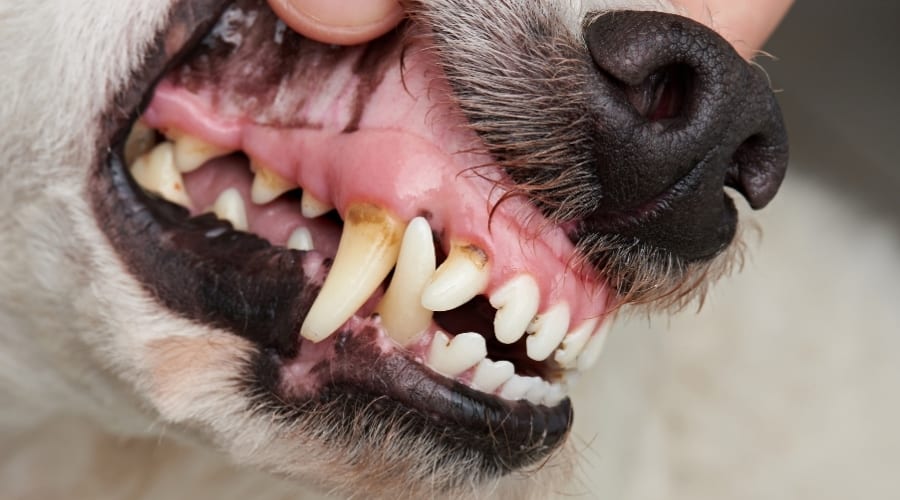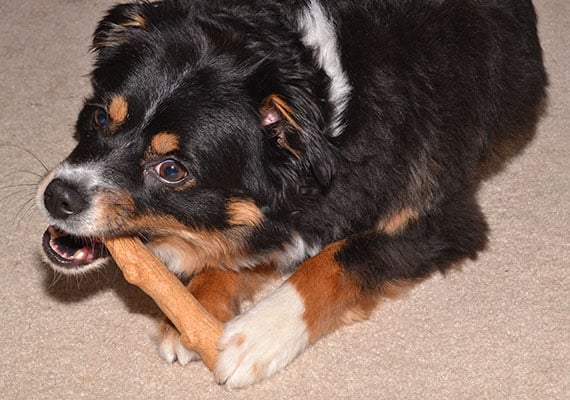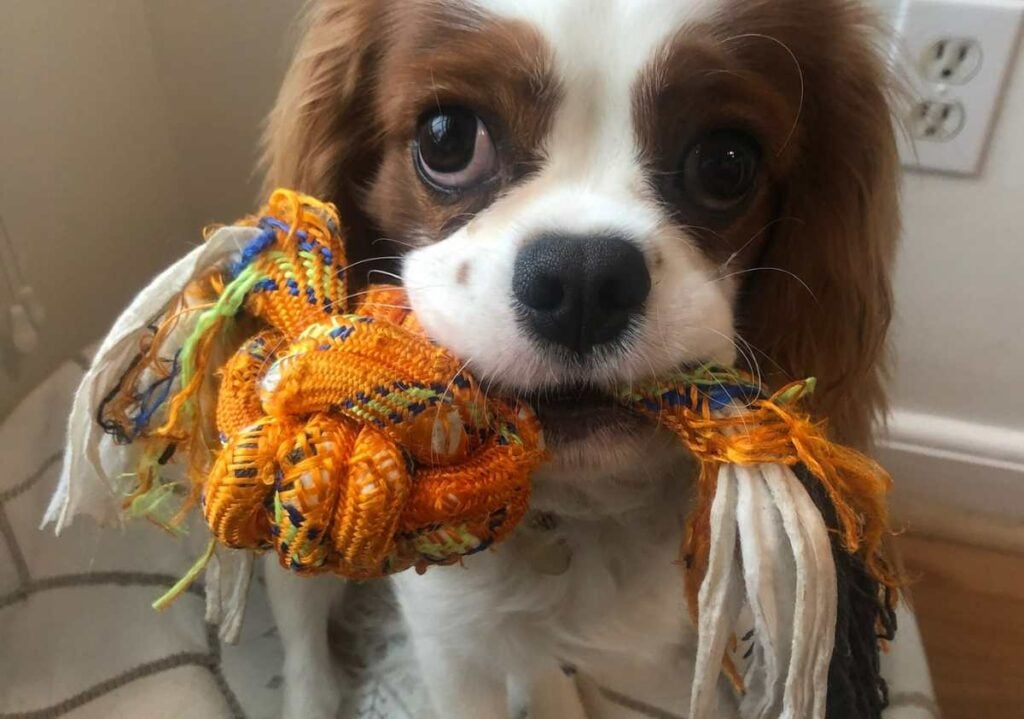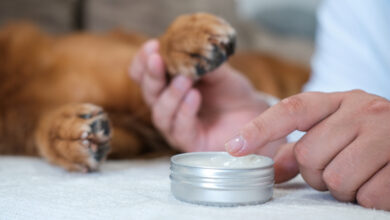Slab Fractures In Dogs: What Are They And What Should You Do?
When you purchase through links on our site, we may earn a commission. Here’s how it works.
If you’re a pet parent to a dog, you’re hopefully already aware of the importance of keeping your four-legged friend’s teeth and gums healthy. So, you might already give your dog plenty of chews and toys to chew on, but did you know these can sometimes cause damage to the teeth?
Table of Contents
Slab fractures in dogs and other types of tooth fractures are relatively common. Let’s discover why they happen and how to prevent your dog from a broken tooth.

What Is A Slab Fracture In A Dog?
A slab fracture is a type of tooth fracture that usually affects the carnassial teeth (the largest multi-rooted molars in your dog’s mouth). A slab fracture occurs when a crack forms and a slab of the tooth’s crown breaks off.
However, a slab fracture doesn’t always occur completely above the gumline. If your dog is particularly unlucky, a portion of the tooth root can also come away.
This injury can be incredibly painful because a slab fracture usually exposes the sensitive pulp cavity (where the nerves and blood vessels are inside the tooth).
It’s not just the pain of a severe and constant toothache that is a concern though. Exposed pulp cavity also means that bacteria can get into the tooth or even the bloodstream.
This bacteria can cause painful tooth root infections, abscesses, and a risk of septicemia.
What Causes A Slab Fracture?
A dog slab fracture can be caused by chewing on anything particularly hard, whether it’s a bone, a stone, or an antler chew.

In fact, chewing on softer items can also occasionally cause damage, especially if your dog has weakened teeth or if they chew at the wrong angle.
I have seen quite a few cases with tooth damage from chewing over the years, including multiple Staffordshire Bull Terriers with teeth that have worn down but, thankfully, not fractured after years of stone chewing.
However, I also remember seeing a young Labrador Retriever with a slab fracture of his carnassial that extended below the gum line. The cause was a bone he had been fed.
Since then, he’d been in pain in his mouth, dribbling and struggling to eat. It was the first time he’d had a bone, so it was particularly unlucky. He ended up having the tooth surgically removed.
What To Do If Your Dog Breaks A Tooth
If you notice that your dog has mouth pain or is having trouble eating or picking up toys, it’s a good idea to have a look in their mouth.
If you notice that they have a broken tooth, it’s important to take them to the veterinarian.
However, broken teeth may not be as obvious as you might think, especially if they have cracked but not completely separated.
Therefore, if the signs don’t improve, it’s still a good idea to seek veterinary advice even if you can’t see anything wrong.
Slab Fracture Dog Treatment
The treatment required for a dog slab fracture will depend on the extent of the tooth damage. If your dog is lucky enough that the pulp cavity is not exposed and the root is still intact, no treatment could be required. Although it’s likely that the tooth will be weakened, so they mustn’t chew on anything hard in the future.
However, if the pulp cavity is exposed or the root damaged, your dog will either need to have the tooth removed or visit a veterinary dental specialist. A specialist may be able to perform a root canal or other salvage procedure to allow the dead tooth to stay in place without pain or risk of infection.
These procedures require a great level of expertise and can be costly. Therefore, extraction may be the more suitable option for your dog.
Surgical Extraction
If your dog has a slab fracture, even a tooth extraction isn’t straightforward because what remains of the tooth may be brittle, and fragments could easily be left behind.
Your veterinarian may elect to perform a surgical extraction, where the gum is lifted away, and the bone of the jaw gradually drilled to expose the root to enable safe removal.
If your dog does require a surgical tooth extraction, they will have dissolvable stitches in their mouth which will take a few weeks to dissolve.
Thankfully, with soft food and pain relief, they should recover well and will manage fine without the tooth.
How Much Does Treating A Dog Slab Fracture Cost?
The exact cost of treating a slab fractured dog tooth will depend on where you live, the clinic you visit, and the chosen treatment.
The most common treatment is the extraction of the tooth, which often requires surgery to raise the gum and expose the tooth roots by removing some of the jawbone.
A surgical extraction is particularly likely in a carnassial slab fracture. If you decide you’d like to explore the option of saving the tooth, your veterinarian can recommend a dental specialist. However, this treatment is likely to be much more costly.
Here are some average costs for veterinary dental work associated with tooth fractures:
- Blood work: $75–$200
- X-rays: $150–$250
- Anesthesia: $100–$400
- Tooth extraction: $50-$500 each
- Pain meds & antibiotics: $50–$100
- Follow-up visits: $50–$100 each
Did You Know?
Some, but not all, pet insurance providers cover costs for extensive dental work in addition to diagnostics and treatment for a wide variety of accidents and illnesses. See our reviews of the best pet dental insurance to find out which companies have the best dental benefits. Some providers also offer wellness plan add-ons that help cover the cost of annual professional teeth cleanings, as well as other preventative care.

Can You Prevent Slab Fractures?
Avoid letting your dog chew on anything hard as it will help to prevent tooth wear or fractures unless they have a health condition that causes them to have weak teeth and bones. So, although they might enjoy a bone or an antler chew now and then, it’s much safer not to let them.
Similarly, chewing stones can cause huge damage to teeth, so if you can discourage this you can help to prevent a tooth fracture.
What Types Of Chews And Treats Are Safest For Dogs?
I know what you’re thinking – ‘But don’t dogs need chews to keep their teeth healthy?’ Well, the friction of chewing certain items will indeed help break up the film of bacteria that coats the teeth, resulting in less plaque and tartar.
However, choose a chew that’s too hard, and your dog might be at risk of more severe tooth damage despite your best intentions.

In addition to that, there is the risk of bones and other hard chews causing gut obstructions or splinters, and you can see why it might be best to avoid them.
If you want to keep your dog’s teeth as healthy as possible, you might want to consider giving small amounts of raw carrots or speaking to your veterinarian about other options.
Some good alternatives include dental chews for dogs or our picks for the best indestructible chew toys that aren’t too hard.
How Can You Keep Your Dog’s Teeth As Healthy As Possible?
Aside from avoiding bones and hard chews, the best thing you can do for your dog’s teeth is to brush them to help prevent gum disease. If your dog allows you, brushing them daily will help to prevent the buildup of bacteria, plaque, and tartar. This keeps their gums and teeth healthy and pain-free, with the added bonus of less smelly breath. Check out our reviews of the best dog toothbrushes.
If this isn’t an option there are various other dental health products for dogs, including antibacterial rinses, gels, and additives for drinking water. Your veterinarian will be able to help you come up with a home care plan for your dog’s teeth. You may also want to read our article on the best toothpaste for dogs, including brushless options, dental wipes, and more.



